Table of Contents
Class 11 Physics NCERT Exemplar Solutions for Chapter 15 Waves
Multiple Choice Questions I
15.1. Water waves produced by a motorboat sailing in water are
a) neither longitudinal nor transverse
b) both longitudinal and transverse
c) only longitudinal
d) only transverse
Answer:
The correct answer is b) both longitudinal and transverse
15.2. Sound waves of wavelength λ travelling in a medium with a speed of v m/s enter into another medium where its speed is 2v m/s. The wavelength of sound waves in the second medium is
a) λ
b) λ/2
c) 2 λ
d) 4 λ
Answer:
The correct answer is c) 2 λ
15.3. Speed of sound wave in air
a) is independent of temperature
b) increases with pressure
c) increases with an increase in humidity
d) decreases with an increase in humidity
Answer:
The correct answer is c) increases with an increase in humidity
15.4. Change in temperature of the medium changes
a) frequency of sound waves
b) amplitude of sound waves
c) wavelength of sound waves
d) loudness of sound waves
Answer:
The correct answer is c) wavelength of sound waves
15.5. With the propagation of longitudinal waves through a medium, the quantity transmitted is
a) matter
b) energy
c) energy and matter
d) energy, matter, and momentum
Answer:
The correct answer is b) energy
15.6. Which of the following statements are true for wave motion?
a) mechanical transverse waves can propagate through all mediums
b) longitudinal waves can propagate through solids only
c) mechanical transverse waves can propagate through solids only
d) longitudinal waves can propagate through a vacuum
Answer:
The correct answer is c) mechanical transverse waves can propagate through solids only
15.7. A sound wave is passing through the air column in the form of compression and rarefaction. In consecutive compressions and rarefactions,
a) density remains constant
b) Boyle’s law is obeyed
c) bulk modulus of air oscillates
d) there is no transfer of heat
Answer:
The correct answer is d) there is no transfer of heat
15.8. Equation of a plane progressive wave is given by y = 0.6 sin 2π(t-x/2). On reflection from a denser medium, its amplitude becomes 2/3 of the amplitude of the incident wave
a) y = 0.6 sin 2π(t+x/2)
b) y = -0.4 sin 2π(t+x/2)
c) y = 0.4 sin 2π(t+x/2)
d) y = -0.4 sin 2π(t-x/2)
Answer:
The correct answer is b) y = -0.4 sin 2π(t+x/2)
15.9. A string of mass 2.5 kg is under a tension of 200 N. The length of the stretched string is 20.0 m. If the transverse jerk is struck at one end of the string, the disturbance will reach the other end in
a) one second
b) 0.5 second
c) 2 seconds
d) data given is insufficient
Answer:
The correct answer is b) 0.5 second
15.10. A train whistling at constant frequency is moving towards a station at a constant speed V. The train goes past a stationary observer on the station. The frequency n’ of the sound as heard by the observer is plotted as a function of time t. Identify the expected curve
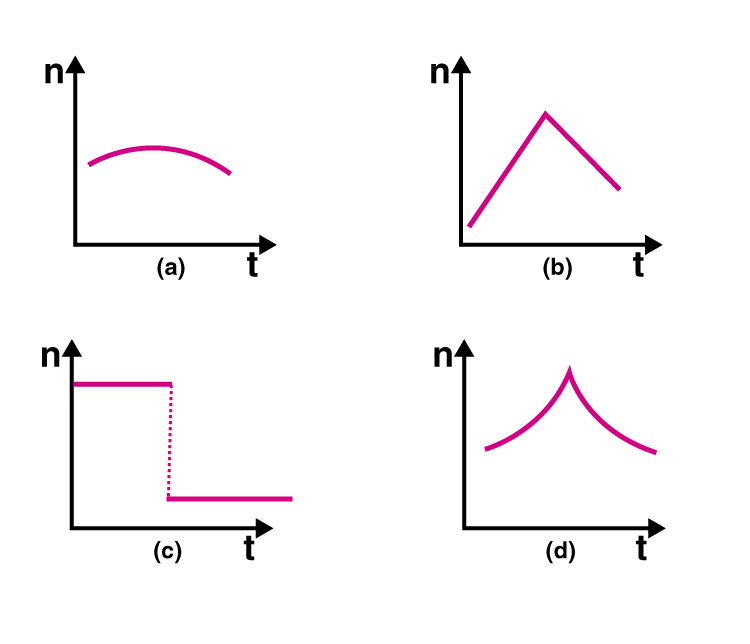
Answer:
The correct answer is c)
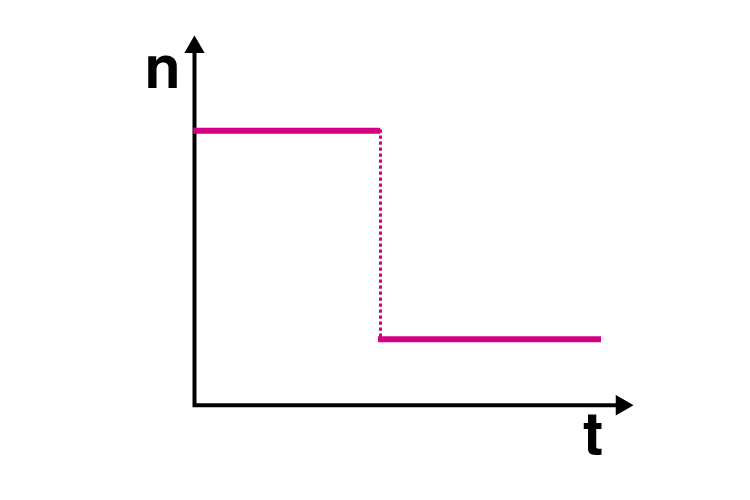
Multiple Choice Questions II
15.11. A transverse harmonic wave on a string is described by y (x,t) = 3.0 sin (36t + 0.018x + π/4) where x and y are in cm and t is in s. The positive direction of x is from left to right
a) the wave is travelling from right to left
b) the speed of the wave is 20 m/s
c) frequency of the wave is 5.7 Hz
d) the least distance between two successive crests in the wave is 2.5 cm
Answer:
The correct answers are
a) the wave is travelling from right to left
b) the speed of the wave is 20 m/s
c) frequency of the wave is 5.7 Hz
15.12. The displacement of a string is given by y(x,t) = 0.06 sin (2πx/3) cos (120πt) where x and y are in m and t in s. The length of the string is 1.5 m and its mass is 3.0 × 10-2kg.
a) it represents a progressive wave of frequency 60 Hz
b) it represents a stationary wave of frequency 60 Hz
c) it is the result of the superposition of two waves of wavelength 3 m, frequency 60 Hz each travelling with a speed of 180 m/s in the opposite direction
d) amplitude of this wave is constant
Answer:
The correct answers are
b) it represents a stationary wave of frequency 60 Hz
c) it is the result of the superposition of two waves of wavelength 3 m, frequency 60 Hz each travelling with a speed of 180 m/s in the opposite direction
15.13. Speed of sound waves in a fluid depends upon
a) directly on the density of the medium
b) square of bulk modulus of the medium
c) inversely on the square root of density
d) directly on the square root of bulk modulus of the medium
Answer:
The correct answers are
c) inversely on the square root of density
d) directly on the square root of bulk modulus of the medium
15.14. During propagation of a plane progressive mechanical wave
a) all the particles are vibrating in the same phase
b) amplitude of all the particles is equal
c) particles of the medium executes SHM
d) wave velocity depends upon the nature of the medium
Answer:
The correct answers are
b) amplitude of all the particles is equal
c) particles of the medium executes SHM
d) wave velocity depends upon the nature of the medium
15.15. The transverse displacement of a string is given by y(x,t) = 0.06 sin (2πx/3) cos (120πt). All the points on the string between two consecutive nodes vibrate with
a) same frequency
b) same phase
c) same energy
d) different amplitude
Answer:
The correct answers are
a) same frequency
b) same phase
d) different amplitude
15.16. A train, standing in a station yard, blows a whistle of frequency 400 Hz in still air. The wind starts blowing in the direction from the yard to the station with a speed of 10 m/s. Given that the speed of sound in still air is 340 m/s
a) the frequency of sound as heard by an observer standing on the platform is 400 Hz
b) the speed of sound for the observer standing on the platform is 350 m/s
c) the frequency of sound as heard by the observer standing on the platform will increase
d) the frequency of sound as heard by the observer standing on the platform will decrease
Answer:
The correct answers are
a) the frequency of sound as heard by an observer standing on the platform is 400 Hz
b) the speed of sound for the observer standing on the platform is 350 m/s
15.17. Which of the following statements are true for a stationary wave?
a) every particle has a fixed amplitude which is different from the amplitude of its nearest particle
b) all the particles cross their mean position at the same time
c) all the particles are oscillating with the same amplitude
d) there is no net transfer of energy across any plane
e) there are some particles which are always at rest
Answer:
The correct answers are
a) every particle has a fixed amplitude which is different from the amplitude of its nearest particle
b) all the particles cross their mean position at the same time
d) there is no net transfer of energy across any plane
e) there are some particles which are always at rest
Very Short Answer
15.18. A sonometer wire is vibrating in resonance with a tuning fork. Keeping the tension applied same, the length of the wire is doubled. Under what conditions would the tuning fork still be is resonance with the wire?
Answer:
The length of the wire used in a sonometer is twice when it vibrates. Therefore, if the tuning fork resonates at L, the sonometer resonates at 2L. The following equation is used to express the frequency of the sonometer

The velocity of the wave from the sonometer is constant. The resonance between the tuning fork and the wire will remain even after the change in the length of the wire.
Then,
n/L = constant
Which also means that,
n1/L1 = n2/L2
n1/L1 = n2/2L2
n2 = 2n1
Therefore, when the wire length is doubled, the resonance also gets doubled.
15.19. An organ pipe of length L open at both ends is found to vibrate in its first harmonic when sounded with a tuning fork of 480 Hz. What should be the length of a pipe closed at one end, so that it also vibrates in its first harmonic with the same tuning fork?
Answer:
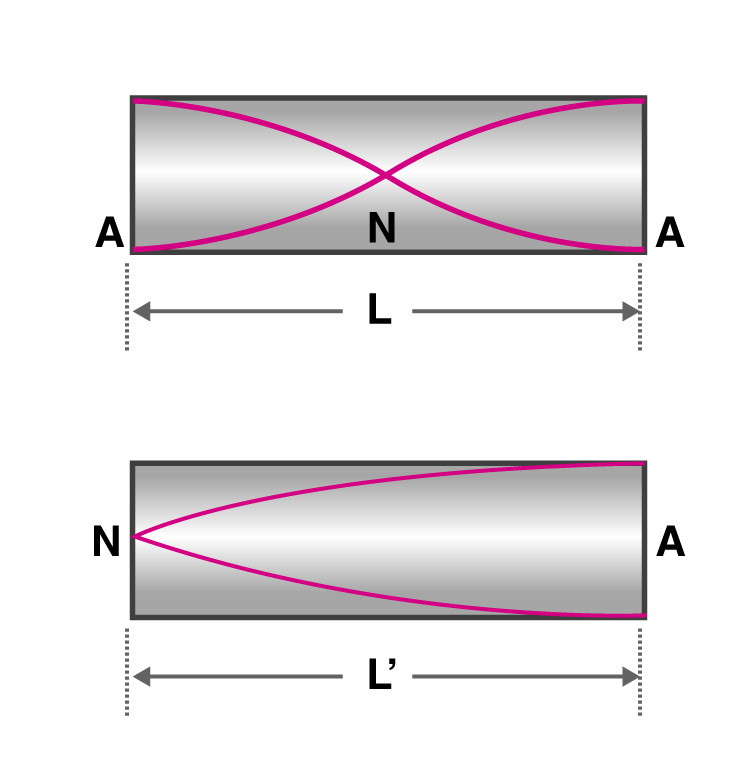
From the harmonic is open, L = λ/2
λ = 2L
v/f0 = 2L
(f0)open = v/2L
where v is the speed of the sound wave in the air.
When the harmonic is closed, L’ = λ/4
λ = 4L’
(f0)closed = v/4L’
v/2L = v/4L’
L’ = L/2
15.20. A tuning fork A, marked 512 Hz, produces 5 beats per second, where sounded with another unmarked tuning fork B. If B is loaded with wax the number of beats is again 5 per second. What is the frequency of the tuning fork B when not loaded?
Answer:
When the tuning fork B is loaded with the wax, the frequency of the tuning fork becomes less than its original frequency. When the tuning fork is marked 512 Hz, let’s assume that the tuning fork B is marked to 517 Hz because it produces 5 beats per second and when it is loaded, the frequency is less than 512 Hz. So it can be said that when the tuning fork is not loaded, the frequency remains the same that is 517 Hz.
15.21. The displacement of an elastic wave is given by the function y = 3 sin ωt + 4 cos ωt where y is in cm and t is in second. Calculate the resultant amplitude.
Answer:
Given,
y = 3 sin ωt + 4 cos ωt
Let’s consider
3 = a cos φ
4 = a sin φ
Then
y = a cos φ ωt + a sin φ ωt
y = a sin (ωt + φ)
tan φ = 4/3
φ = tan-1 4/3
When the above equation is squared, we het
a2 = 25
a = 5
Therefore, the new amplitude is 5 cm.
15.22. A sitar wire is replaced by another wire of same length and material but of three times earlier radius. If the tension in the wire remains the same, by what factor will the frequency change?
Answer:
The frequency of the stretched wire is given as:

Given that,
No.of harmonic n, length L, and tension T are the same in both the cases.
Therefore,

Substituting the values of mass per unit length, we get

Solving the above the equation, we get v2 = 1/3 v1
Therefore, the frequency of sitar is reduced by 1/2 of its actual value.
15.23. At what temperatures will the speed of sound in air be 3 times its value at 0oC?
Answer:
We know that,
![]()
Given that,
vT = 3v0

T = 2457 – 273 = 2184oC
15.24. When two waves of almost equal frequencies n1 and n2 reach at a point simultaneously, what is the time interval between successive maxima?
Answer:
It is given that the two frequencies are almost equal, that is n1 = n2.
For the formation of the beats, the frequencies must be n2 > n1.
The no.of frequencies per second in maxima = n = n2 – n1
Therefore, the time period of the maxima = 1/n = 1/n2 – n1 second.
Short Answers
15.25. A steel wire has a length of 12 m and a mass of 2.10 kg. What will be the speed of a transverse wave on this wire when a tension of 2.06 × 104 N is applied?
Answer:
Length, l = 12 m
Total mass, M = 2.10 kg
m = M/l = 2.1/12
Tension, T = 2.06 × 104 N
Therefore, v is given as

v = 343.0 m/s
15.26. A pipe of 20 cm long is closed at one end. Which harmonic mode of the pipe is resonantly excited by a source of 1237.5 Hz?
Answer:
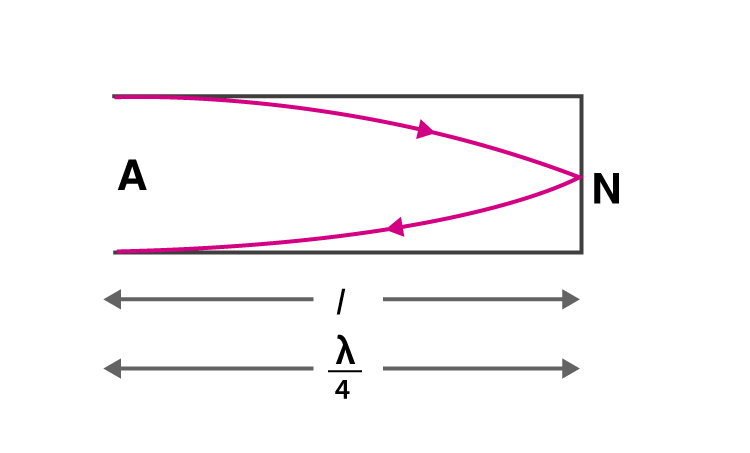
Given,
Length, l = 20 cm =0.2 m
v = 1237.5 Hz
Assuming that velocity of sound in air = 330 m/s
l = λ/4
λ = 4l
We know that,
v1= v/ λ = v/4l
v1 = 412.5 Hz
v/v1 = 1237.5/412.5 = 3/1
Therefore, the third harmonic will have 1237.5 Hz frequency.
15.27. A train standing at the outer signal of a railway station blows a whistle of frequency 400 Hz still air. The train beings to move with a speed of 10 m/s towards the platform. What is the frequency of the sound for an observer standing on the platform?
Answer:
v0 = 400 Hz
vz = 10 m/s
Velocity of sound in air, va = 330 m/s
v’ is the frequency heard by the observer standing on the platform
v’ = (330)(400)/320 = 412.5 Hz
15.28. The wave pattern on a stretched string is shown in the figure. Interpret what kind of wave this is and find its wavelength.
Answer:
When particles at t = T/4 and 3T/4 are at rest on a stationary wave at its mean position.
When the wave is at x = 10, 20, 30, 40 cm, the nodes in the graph have a distance with the successive node is λ/2.
λ/2 = 30 – 20 = 20
λ = 20 cm
15.29. The pattern of standing waves formed on a stretched string at two instants of time is shown in the figure. The velocity of two waves superimposing to form stationary waves is 360 m/s, and their frequencies are 256 Hz.
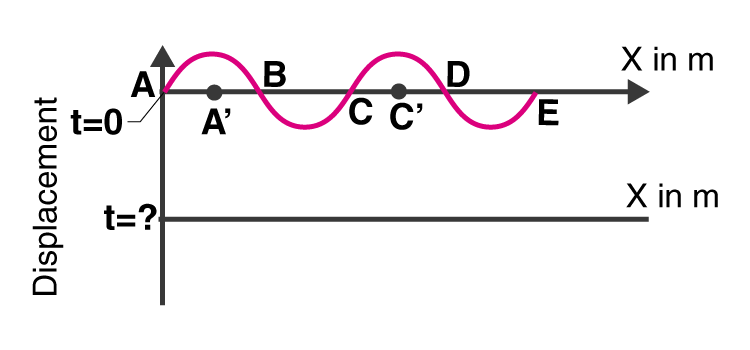
a) calculate the time at which the second curve is plotted
b) mark nodes and antinodes on the curve
c) calculate the distance between A’ and C’
Answer:
The frequency of the wave, v = 256 Hz
T = 1/v = 1/256 sec = 0.00390
T = 3.9 × 10-3 sec
a) When the particle’s mean position changes after T/4, the time is calculated as
t = T/4 = (3.9 10-3)/4 = 0.975 × 10-3 sec
t = 9.8 × 10-4 sec
b) Nodes: A, B, C, D, E
Antinode: A’, C’
c) The distance between A’ and C’ is
λ = v/f = 360/256 = 1.41 m
15.30. A tuning fork vibrating with a frequency of 512 Hz is kept close to the open end of a tube filled with water. The water level in the tube is gradually lowered. When the water level is 17 cm below the open end, the maximum intensity of sound is heard. If the room temperature is 20oC, calculate
a) speed of sound in air at room temperature
b) speed of sound in air at 0oC
c) if the water in the tube is replaced with mercury, will there be any difference in your observations?

Answer:
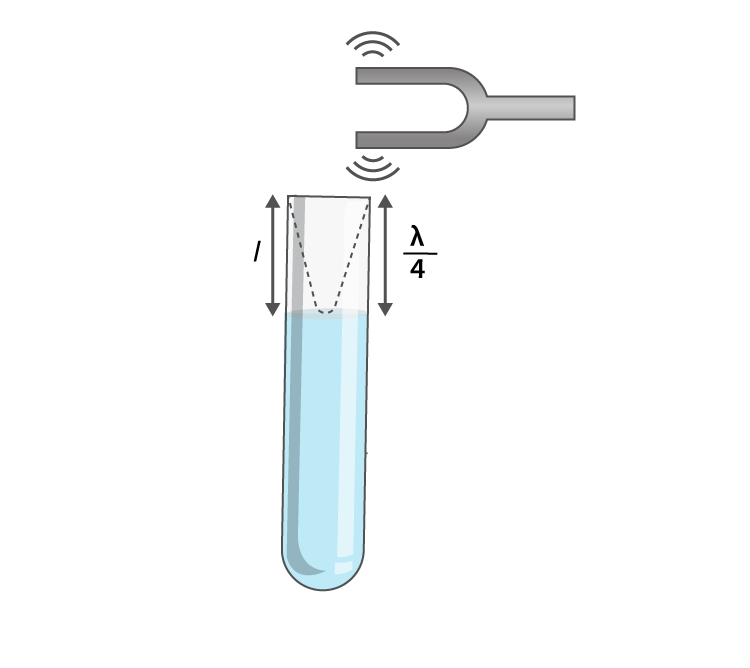
Given,
The frequency of the tuning fork, f = 512 Hz
a) When the first maxima is considered, the length in the air column is, l = λ/4
λ = 4l
Speed of sound, v = f λ = 348.16 m/s
b) We know that,
![]()

15.31. Show that when a string fixed at its two ends vibrates in 1 loop, 2 loops, 3 loops, and 4 loops, the frequencies are in the ratio 1:2:3:4.
Answer:
When n = 1, f1 = v/2L which is known as the fundamental frequency.
When n = 2, f2 = 2(v/2L) which is known as the first overtone.
When n = 3, f3 = 3(v/2L) which is known as second overtone.
When n = 4, f4 = 4(v/2L) which is known as third overtone.
In all the cases, the tone is equal to the fundamental frequency.
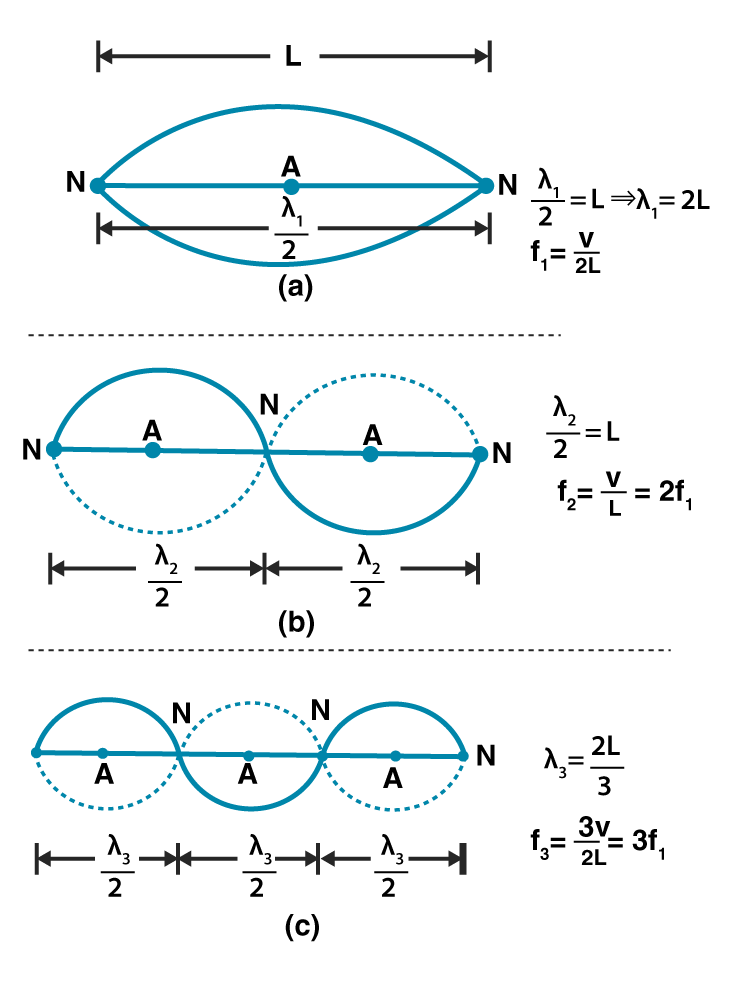
Long Answers
15.32. The earth has a radius of 6400 km. The inner core of the 1000 km radius is solid. Outside it, there is a region from 1000 km to a radius of 3500 km which is in a molten state. Then again from 3500 km to 6400 km the earth is solid. Only longitudinal (P) waves can travel inside a liquid. Assume that the P wave has a speed of 8 km/s in solid parts and of 5 km/s in liquid parts of the earth. An earthquake occurs at someplace close to the surface of the earth. Calculate the time after which it will be recorded in a seismometer at a diametrically opposite point on the earth if wave travels along diameter?
Answer:
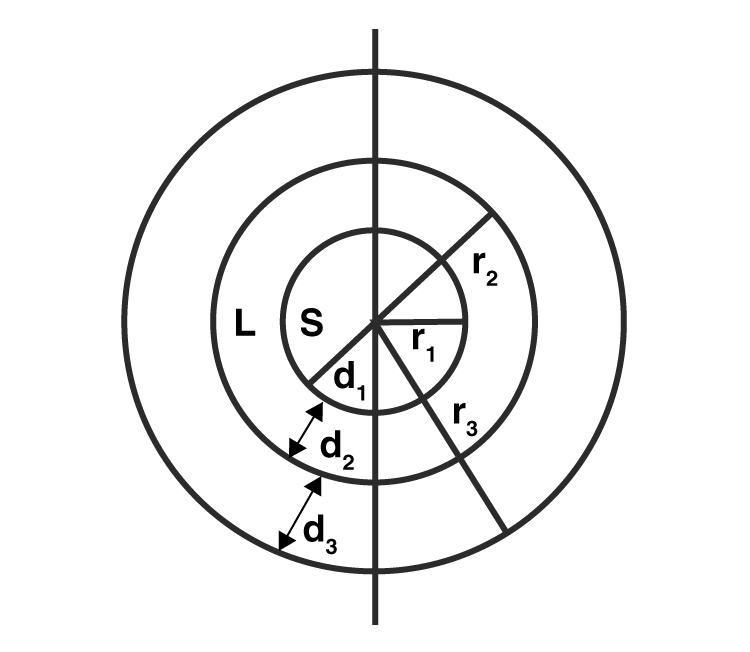
Given,
r1 = 1000 km
r2 = 3500 km
r3 = 6400 km
d1 = 1000 km
d2 = 3500 – 1000 = 2500 km
d3 = 6400 – 3500 = 2900 km
The solid distance is given as:
2(d1 + d3) = 2(1000 + 2900)
Time taken by the wave during the production of an earthquake is
(3900)(2)/8 sec
Liquid distance = 2d2 = (2)(2500)
Time taken by the seismic wave in the liquid part is
(2)(2500)/5
Therefore, total time taken = time taken by the wave during the production of an earthquake + time taken by the seismic wave in the liquid part
= 32 minutes 55 seconds
15.33. If c is r.m.s speed of molecules in a gas and v is the speed of sound waves in the gas, show that c/v is constant and independent of temperature for all diatomic gases.
Answer:
We know following is the equation for molecules:


p/ρ = PT/M
Where, M is the molar mass of the gas

c/v is given as:
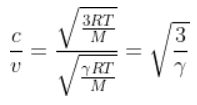
Therefore,

15.34. Given below are some functions of x and t to represent the displacement of an elastic wave.
a) y = 5 cos (4x) sin (20t)
b) y = 4 sin (5x-t/2) + 3 cos (5x-t/2)
c) y = 10 cos [(252-250)πt] cos [(252+250) πt]
d) y = 100 cos (100 πt + 0.5x)
State which of these represent
a) a travelling wave along -x direction
b) a stationary wave
c) beats
d) a travelling wave along +x direction
Give reasons for your answers
Answer:
a) When a wave travels in (-x) direction, it must have +kx which is given as:
d) y = 100 cos (100 πt + 0.5x)
b) When a stationary wave is there then,
a) y = 5 cos (4x) sin (20t)
c) When beats are involved
c) y = 10 cos [(252-250)πt] cos [(252+250) πt]
d) a travelling wave along +x direction is
b) y = 4 sin (5x-t/2) + 3 cos (5x-t/2)
15.35. In the given progressive waves y = 5 sin (100 πt – 0.4 πx) where y and x are in m, t is in s. What is the
a) amplitude
b) wavelength
c) frequency
d) wave velocity
e) particle velocity amplitude
Answer:
Given,
The wave is travelling in +x direction
The equation is
y = 5 sin (100 πt – 0.4 πx)
a) amplitude, a = 5 m
b) wavelength, λ = 2π/ λ = 5 m
c) frequency, v = 50 Hz
d) wave velocity, v = 250 m/s
e) particle velocity amplitude = 500 π m/s
15.36. For the harmonic travelling wave y = 2 cos 2 π(10t-0.0080x+3.5) where x and y are in cm and t is second. What is the phase difference between the oscillatory motion at two points separated by a distance of
a) 4 m
b) 0.5 m
c) λ/2
d) 3 λ/4
e) what is the phase difference between the oscillation of a particle located at x = 100 cm at t = Ts and t = 5s?
Answer:
Given,
y = 2 cos 2 π(10t-0.0080x+3.5)
a = 2
ω = 20 π
k = 0.016 π
φ = 7 π
a) path difference, p = 4m = 400 cm
Substituting the values, we get phase difference = 6.4 πrad
b) path difference, p = 0.5 m = 50 cm
Substituting the values, we get phase difference = 0.8 π rad
c) path difference, p = λ/2
Substituting the values, we get phase difference = π rad
d) path difference, p = 3 λ/4
Substituting the values, we get phase difference = 98 π rad
About Infinity Learn Solutions
Infinity Learn mission is to create world-class learning content for students. We are focussed on raising the students learning abilities. These Solutions have been structured very carefully to give several benefits to the students that utilize these study materials. That is why, these are crafted by subject matter experts to focus on concept and its explanation.For any type of support related to the NCERT Exemplar Solutions for Class 11 given here, students can approach our support team who will help clear all their doubts. Students can also check out Infinite Learn for a more efficient learning experience.
Frequently Asked Questions
Why should I refer to these NCERT Exemplar Solutions?
The NCERT Exemplar Solutions of this Chapter by infinite learn are made with the main aim of helping students to focus on the important concepts. Each and every detail is explained with utmost care to enhance the conceptual knowledge among students. The solutions consists of various shortcut techniques which can be used to remember the concepts effectively. Students use the solutions while answering the textbook questions and understand the method of answering them without any difficulty.
How to score full marks in Chapter 15 of NCERT Exemplar Solutions for Class 11 Physics?
The NCERT Exemplar Solutions of this Chapter is prepared by our highly experienced faculty after doing vast research on each concept. During solving of textbook questions, students can use these solutions to get an overall idea about the topics covered in this chapter. The solutions are provided in both online and offline mode as per the needs of students. The PDF format of solutions are available at Infinite learn which can be downloaded and used by the students to get their doubts cleared instantly.
How to differentiate the transverse and longitudinal waves in these NCERT Exemplar Solutions?
The waves and its properties are the major concepts which is included in Chapter 15. From this, students can differentiate longitudinal and transverse as how the question is present in NCERT textbook. Students can also download the NCERT Exemplar Solutions from Infinite learn in order to clearly understand the concepts, which are important according to the second term CBSE Syllabus for Class 11.
Why Opt for Infinity Learn?
In this chapter Infinity Learn provides videos, notes, NCERT text book solutions, other practice book solutions and assignments that help you learn the concepts and to memorise the concepts for entrance exams and board exams. Most important, Infinity learn provide instant doubt support by subject experts.
Now you can find answer to all your subject queries & prepare for your Exams on our Educational App – Infinity Learn.









